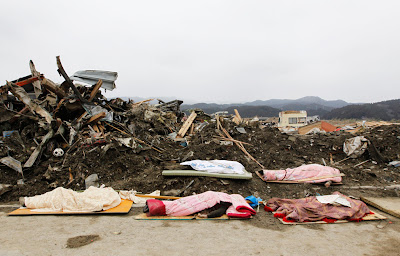 |
| A man shops in a convenience store where shelves on food aisles are left empty in Ofunato, Iwate Prefecture, March 15, 2011. (Shizuo Kambayashi/Associated Press) |
 |
| A radiation detector marks 0.6 microsieverts, exceeding normal day data, March 15, 2011, near Shibuya train station in Tokyo. (Associated Press/Kyodo News) |
 |
| An official wearing a protective suit helps usher people through a radiation emergency scanning center in Koriyama, Japan, March 15, 2011. (Mark Baker/Associated Press) |
 |
| People wait to receive medical treatment at a shelter for earthquake and tsunami evacuees in Rikuzentakata in Iwate prefecture, northeast Japan, March 15, 2011. (Lee Jae-Won/Reuters) |
 |
| Survivors listen about ongoing recovery operations at an evacuation center in Minamisanriku, Miyagi Prefecture, March 15, 2011. (Shuji Kajiyama/Associated Press) |
 |
| Two elderly couples greet each other at a shelter as they reunite, March 15, 2011. (Lee Jae-Won/Reuters) |
 |
| Displaced residents sit on mats at an evacuation center after leaving their coastal homes in Sendai, Miyagi on March 15, 2011. (Mike Clarke/Getty Images) |
 |
| A woman reunites with her relatives at a shelter for the first time after an earthquake and tsunami in Rikuzentakata in Iwate prefecture, March 15, 2011. (Lee Jae-Won/Reuters) |
 |
| People receive emergency clothing aid at a makeshift shelter in Fukushima, March 15, 2011. (Associated Press/The Yomiuri Shimbun, Shuhei Yokoyama) |
 |
| An evacuee reacts after being reunited with her daughter and her brother at a shelter in Rikuzentakata, Iwate, March 15, 2022. Masahiro Ogawa/Associated Press) |
 |
| Evacuees exercise at a makeshift shelter in Minamisanriku, northern Japan, March 15, 2011. (Associated/The Yomiuri Shimbun, Tsuyoshi Matsumoto) |
 |
| Residents eat emergency rations in a candle-lit shelter after leaving their tsunami devastated areas, in Minamisanriku, Miyagi prefecture on March 15, 2011. (Kazuhiro Nogi/AFP/Getty Images) |
 |
| A Japanese survivor of the earthquake and tsunami rides his bicycle through the leveled city of Minamisanriku, in northeastern Japan, March 15, 2011. (David Guttenfelder/Associated Press) |
 |
| Tsunami debris is scattered over a devastated area of Sendai, Miyagi prefecture. (March 14, 2011) (STR/AFP/Getty Images) |
 |
| Rescuers end the day's search operation in the area hard hit by earthquake-triggered tsunami in Sendai, Miyagi Prefecture, Japan, March 15, 2011. (Associated Press/Junji Kurokawa) |
 |
| Japanese military walk by a body lying in the rubble of a village destroyed, March 15, 2011 in Rikuzentakata, Miyagi province. (Paula Bronstein /Getty Images) |
 |
| Family photo albums lie in the ruins of the devastated residential area of tsunami hit Otsuchi March 15, 2011. (Damir Sagolj/Reuters) |
 |
| Rescue workers search through ruins of the devastated residential area of tsunami hit Otsuchi March 15, 2011. (Aly Song/Reuters) |
 |
| Tsunami debris is scattered over a devastated area of Sendai, Miyagi prefecture. (STR/AFP/Getty Images) |
 |
| Japanese recovery officials search through the ruins of the leveled city of Minamisanriku, in northeastern Japan, March 15, 2011. (David Guttenfelder/Associated Press) |
 |
| British search and rescue workers search under a roof removed from a house for survivors of the tsunami in Ofunato, Japan, March 15, 2011. (Matt Dunham/Associated Press) |
 |
| A man stands amidst the destruction in Kesennuma City on March 15, 2011, days after the area was devastated by a magnitude 9.0 earthquake and tsunami. (Adrees Latif/Reuters) |
 |
| Members of Japan's Self Defense Force walk past the body of a woman at an area hit by an earthquake and tsunami in Rikuzentakata, Iwate prefecture, March 15, 2011. (Toru Hanai/Reuters) |
 |
| Japanese survivors of Friday's earthquake and tsunami walk under umbrellas through the leveled city of Minamisanriku, in northeastern Japan, March 15, 2011. David Guttenfelder/Associated Press) |
 |
| Soldiers and a rescue worker carry the body of a victim through Kesennuma City on March 15, 2011. (Adrees Latif/Reuters) |
 |
| Soldiers carry the body of a victim as others prepare to retrieve more in Kesennuma City on March 15, 2011. (Adrees Latif/Retuers) |
 |
| The bodies of victims are covered by blankets at a village destroyed by the earthquake and tsunami in Rikuzentakata in Iwate prefecture, northeast Japan, March 15, 2011. (Lee Jae-Won/Reuters) |
 |
| Two women walk in a tsunami devastated street in Hishonomaki, Miyagi prefecture on March 15, 2011. (Philippe LopezAFP/Getty Images) |
 |
| Local residents pass through a devastated street in Ishinomaki in Miyagi prefecture after the recent tsunami and earthquake, on March 15, 2011. (Kim Jae-Hwan/AFP/Getty Images) |
 |
| Evacuees are screened for radiation contamination at a testing center, March 15, 2011, in Koriyama city, Fukushima Prefecture, northern Japan. (Wally Santana/Associated Press) |






















Hebat Japan..dalam kelaparan/kesusahan masih berlaku budaya antri...
ReplyDeletesalut euy ama jepang..gak nampak perampasan harta orang yg sudah meninggal, negara kita aja, orang yg masih hidup aja dirampas harta-a, apalagi udah mati...tape deh
ReplyDelete